AMD Zen 2 Microarchitecture Analysis: Ryzen 3000 and EPYC Rome
by Dr. Ian Cutress on June 10, 2019 7:22 PM EST- Posted in
- CPUs
- AMD
- Ryzen
- EPYC
- Infinity Fabric
- PCIe 4.0
- Zen 2
- Rome
- Ryzen 3000
- Ryzen 3rd Gen
CCX Size
Moving down in node size brings up a number of challenges in the core and beyond. Even disregarding power and frequency, the ability to put structures into silicon and then integrate that silicon into the package, as well as providing power to the right parts of the silicon through the right connections becomes an exercise in itself. AMD gave us some insight into how 7nm changed some of its designs, as well as the packaging challenges therein.
A key metric given up by AMD relates to the core complex: four cores, the associated core structures, and then L2 and L3 caches. With 12nm and the Zen+ core, AMD stated that a single core complex was ~60 square millimeters, which separates into 44mm2 for the cores and 16mm2 for the 8MB of L3 per CCX. Add two of these 60mm2 complexes with a memory controller, PCIe lanes, four IF links, and other IO, and a Zen+ zeppelin die was 213 mm2 in total.
For Zen 2, a single chiplet is 74mm2, of which 31.3 mm2 is a core complex with 16 MB of L3. AMD did not breakdown this 31.3 number into cores and L3, but one might imagine that the L3 might be approaching 50% of that number. The reason the chiplet is so much smaller is that it doesn’t need memory controllers, it only has one IF link, and has no IO, because all of the platform requirements are on the IO die. This allows AMD to make the chiplets extremely compact. However if AMD intends to keep increasing the L3 cache, we might end up with most of the chip as L3.
Overall however, AMD has stated that the CCX (cores plus L3) has decreased in size by 47%. That is showing great scaling, especially if the +15% raw instruction throughput and increased frequency comes into play. Performance per mm2 is going to be a very exciting metric.
Packaging
With Matisse staying in the AM4 socket, and Rome in the EPYC socket, AMD stated that they had to make some bets on its packaging technology in order to maintain compatibility. Invariably some of these bets end up being tradeoffs for continual support, however AMD believes that the extra effort has been worth the continued compatibility.
One of the key points AMD spoke about with relation to packaging is how each of the silicon dies are attached to the package. In order to enable a pin-grid array desktop processor, the silicon has to be affixed to the processor in a BGA fashion. AMD stated that due to the 7nm process, the bump pitch (the distance between the solder balls on the silicon die and package) reduced from 150 microns on 12nm to 130 microns on 7nm. This doesn’t sound like much, however AMD stated that there are only two vendors in the world with technology sufficient to do this. The only alternative would be to have a bigger bit of silicon to support a larger bump pitch, ultimately leading to a lot of empty silicon (or a different design paradigm).
One of the ways in order to enable the tighter bump pitch is to adjust how the bumps are processed on the underside of the die. Normally a solder bump on a package is a blob/ball of lead-free solder, relying on the physics of surface tension and reflow to ensure it is consistent and regular. In order to enable the tighter bump pitches however, AMD had to move to a copper pillar solder bump topology.
In order to enable this feature, copper is epitaxially deposited within a mask in order to create a ‘stand’ on which the reflow solder sits. Due to the diameter of the pillar, less solder mask is needed and it creates a smaller solder radius. AMD also came across another issue, due to its dual die design inside Matisse: if the IO die uses standard solder bump masks, and the chiplets use copper pillars, there needs to be a level of height consistency for integrated heat spreaders. For the smaller copper pillars, this means managing the level of copper pillar growth.
AMD explained that it was actually easier to manage this connection implementation than it would be to build different height heatspreaders, as the stamping process used for heatspreaders would not enable such a low tolerance. AMD expects all of its 7nm designs in the future to use the copper pillar implementation.
Routing
Beyond just putting the silicon onto the organic substrate, that substrate has to manage connections between the die and externally to the die. AMD had to increase the number of substrate layers in the package to 12 for Matisse in order to handle the extra routing (no word on how many layers are required in Rome, perhaps 14). This also becomes somewhat complicated for single core chiplet and dual core chiplet processors, especially when testing the silicon before placing it onto the package.
From the diagram we can clearly see the IF links from the two chiplets going to the IO die, with the IO die also handling the memory controllers and what looks like power plane duties as well. There are no in-package links between the chiplets, in case anyone was still wondering: the chiplets have no way of direct communication – all communication between chiplets is handled through the IO die.
AMD stated that with this layout they also had to be mindful of how the processor was placed in the system, as well as cooling and memory layout. Also, when it comes to faster memory support, or the tighter tolerances of PCIe 4.0, all of this also needs to be taken into consideration as provide the optimal path for signaling without interference from other traces and other routing.


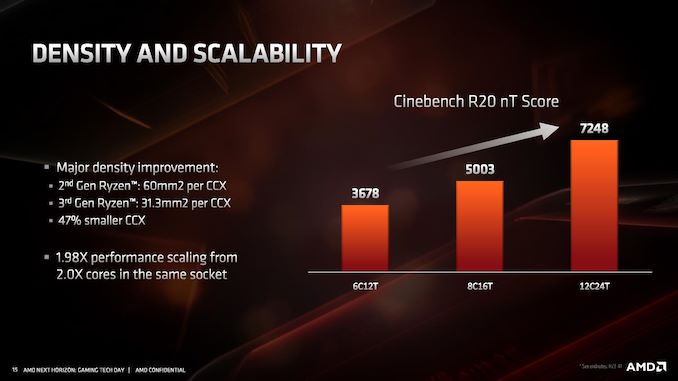
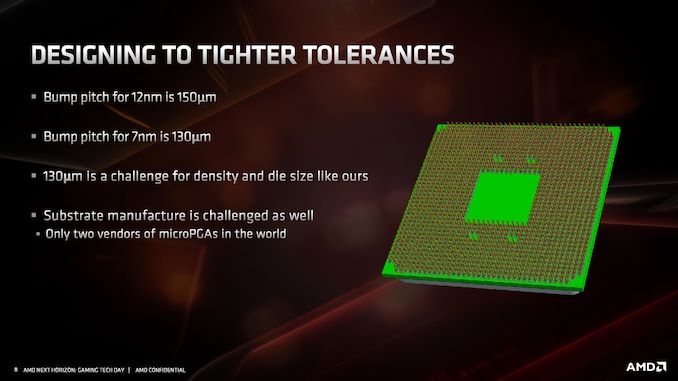
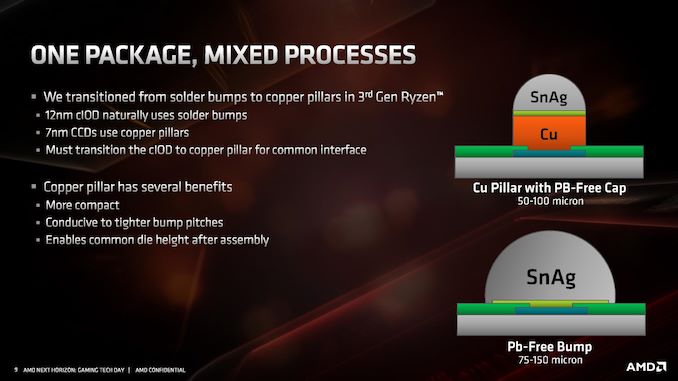
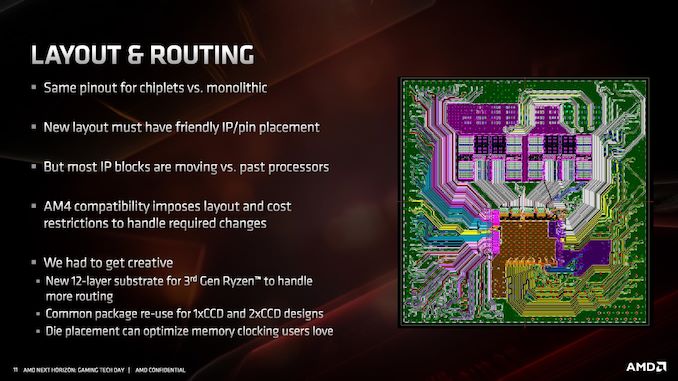
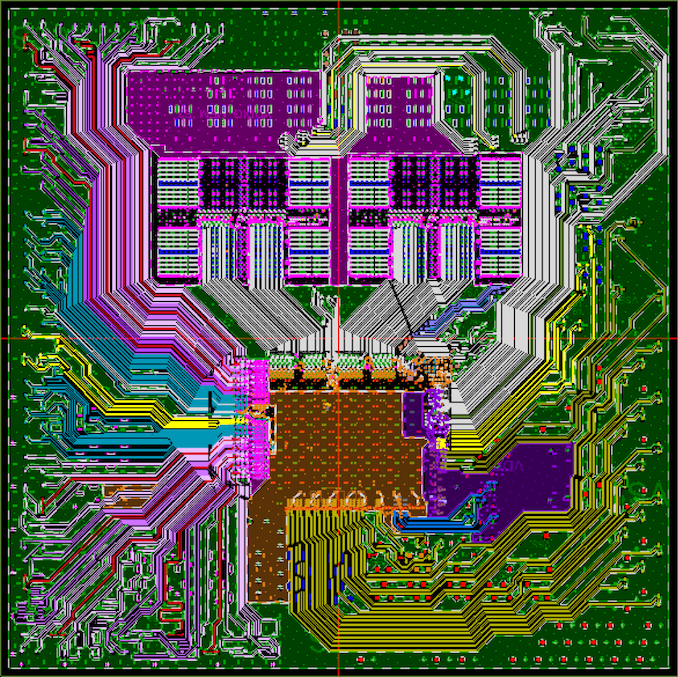








216 Comments
View All Comments
GreenReaper - Tuesday, June 11, 2019 - link
A lot of progress has been made. Browsers are far more multithreaded than they once were - and as web pages become more complex, that benefit can scale. Similarly, databases and rendering can scale very well over certain operations.Said scaling tends to work best for the longest operations, because they can be split up into chunks without too much overhead. The overall impact should be that there are fewer long, noticeable delays. There isn't so much progress for things that are already pretty fast - or long sequences of operations that rely on one another. (However, precomputing and prefetching can help.)
stephenbrooks - Thursday, June 13, 2019 - link
I find it surprising how they add these smallish increases onto execution width, out of order buffers, register files etc. The IPC hasn't stopped increasing, it's just slow-ish. Maybe they're fighting power and latency in those part of the core so the 2x density from a node doesn't translate fully.Santoval - Tuesday, June 11, 2019 - link
Prices should drop when the competition with Intel becomes fiercer. I don't expect that anytime soon though.. It doesn't look like Intel will manage to release Ice Lake CPUs (except apparently the -U and -Y ones they announced) this year or at all.Their 10nm+ node is still having serious issues with clocks and thermals, and the yields are much lower than TSMC's 7nm (high performance) node. So "word on the street" is that they won't release Ice Lake CPUs for desktop at all. Id est that they'll can them and release instead Tiger Lake desktop CPUs fabbed with their fixed (??) 10nm++ node variant late next year (as in Q4 2020).
piroroadkill - Wednesday, June 12, 2019 - link
You're wrong. You get more performance than Intel at a lower price. In the case of the 3950X, it's significant. To sell them cheaper would devalue an incredible product, for no reason.Targon - Thursday, June 13, 2019 - link
Ryzen 7 2700X vs. Ryzen 7 3700X. Same price, better performance. Looking at the 3800X which is $399, look at the IPC+clock speed improvements. The 3900X will obviously come at a cost, because you are getting 50% more cores for that increased price. Single threaded though....at what point do you really focus on how fast or slow a single threaded program is running in this day and age where you run dozens of processes at the same time? If you are running dozens of single threaded programs, then performance will change based on how the OS scheduler assigns them to different CPU cores.Qasar - Thursday, June 13, 2019 - link
jjj" They give us around 20% ST gains (IPC+clocks) but at a cost. " that same thing could be said about intels cpus over the last few years... how much performance increase did they give us year over year ?? all while only giving is 4 cores for the mainstream... amd's prices are just fine.. intel is the one that should be dropping their prices, some as low as the $50 you say, but most, $500 or more
Tunnah - Monday, June 10, 2019 - link
I bet now Intel is just going to completely flood ads with the title "Intel beats AMD in pure FPS tests!", because they'll get 210fps where AMD gets 200. And some people will eat it up.I'm so excited for this upgrade. Replacing a 2700K with a 3800X, where I'll not only get a doubling of cores, but clock for clock I reckon it's a 40, 50% improvement there too.
My Civ games are gonna be so zoomy now..
xrror - Monday, June 10, 2019 - link
Intel will always beat AMD ......
...
(at a price point you don't give a f*ck about) (4 digits or more)
Are you a micro-trader hardwired into the BS Stock Exchange? You think $1000+ is too much for the fully enabled processor arch you want to overclock should cost you?
Sorry, Intel doesn't have the time of day for you after 2011, after Sandy Bridge took away the ability to overclock blessed "K" skus...
oh sure, there are others. IDT and Cyrix are dead but... let me introduce you to...
AMD
xrror - Monday, June 10, 2019 - link
This isn't aimed at you Tunnah. I meant it as humor.Read my comment like some exciting infocommercial, with ... (insert commanding infomercial voice here) hehe
Makaveli - Tuesday, June 11, 2019 - link
The 2700k and the 3800X are both 8C 16T designs.